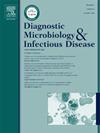Non-invasive diagnosis of pulmonary tuberculosis and predictive potential for treatment outcomes via miR-146a and miR-155 levels
IF 2.1
4区 医学
Q3 INFECTIOUS DISEASES
Diagnostic microbiology and infectious disease
Pub Date : 2025-03-09
DOI:10.1016/j.diagmicrobio.2025.116795
引用次数: 0
Abstract
Use of microRNAs is a promising area for non-invasive diagnosis of pulmonary tuberculosis (TB). Herein, we aimed to investigate the diagnostic potential of miR-146a and miR-155 in pulmonary TB and their predictive potential for patient treatment outcomes. The study included 60 patients with active TB, 50 patients with latent TB, and 50 individuals without TB infection. The patients with active TB were given standard treatment regimens and followed up for treatment outcomes. The serum and sputum expression levels of miR-146a and miR-155 were quantified by qRT-PCR. The patients presenting active TB had highest relative expressions of miR-146a and miR-155 in the serum and sputum compared to patients presenting latent TB and healthy volunteers (p < 0.0001). When miR-146a and miR-155 levels in the serum and sputum as tools to diagnose TB, all values of area under the receiver operating characteristics curve (AUROC) were beyond 0.9. The patients with active TB and presenting unfavorable treatment outcomes were demonstrated with higher relative expressions of miR-146a and miR-155 in the serum and sputum than those presenting favorable treatment outcomes (p < 0.0001). When these two miRNAs as tools to predict treatment outcomes, values of AUROC were beyond 0.85. The study unveils detections of miR-146a and miR-155 in the serum and sputum may be a promising non-invasive method to diagnose TB and further to predict treatment outcomes following anti-TB treatment.
通过miR-146a和miR-155水平对肺结核的无创诊断和治疗结果的预测潜力
使用microRNAs是非侵入性诊断肺结核(TB)的一个有前途的领域。在此,我们旨在研究miR-146a和miR-155在肺结核中的诊断潜力及其对患者治疗结果的预测潜力。该研究包括60名活动性结核病患者,50名潜伏性结核病患者和50名未感染结核病的患者。对活动性结核病患者给予标准治疗方案并随访治疗结果。采用qRT-PCR定量检测血清和痰液中miR-146a和miR-155的表达水平。活动性结核病患者血清和痰中miR-146a和miR-155的相对表达量高于潜伏性结核病患者和健康志愿者(p < 0.0001)。当血清和痰液中miR-146a和miR-155水平作为诊断TB的工具时,受试者工作特征曲线下面积(AUROC)的所有值均大于0.9。治疗效果较差的活动性结核病患者血清和痰中miR-146a和miR-155的相对表达量高于治疗效果较差的患者(p <;0.0001)。当这两种mirna作为预测治疗结果的工具时,AUROC值超过0.85。该研究揭示了在血清和痰液中检测miR-146a和miR-155可能是一种很有前途的非侵入性方法来诊断结核病,并进一步预测抗结核治疗后的治疗结果。
本文章由计算机程序翻译,如有差异,请以英文原文为准。
求助全文
约1分钟内获得全文
求助全文
来源期刊
CiteScore
5.30
自引率
3.40%
发文量
149
审稿时长
56 days
期刊介绍:
Diagnostic Microbiology and Infectious Disease keeps you informed of the latest developments in clinical microbiology and the diagnosis and treatment of infectious diseases. Packed with rigorously peer-reviewed articles and studies in bacteriology, immunology, immunoserology, infectious diseases, mycology, parasitology, and virology, the journal examines new procedures, unusual cases, controversial issues, and important new literature. Diagnostic Microbiology and Infectious Disease distinguished independent editorial board, consisting of experts from many medical specialties, ensures you extensive and authoritative coverage.

 求助内容:
求助内容: 应助结果提醒方式:
应助结果提醒方式:


